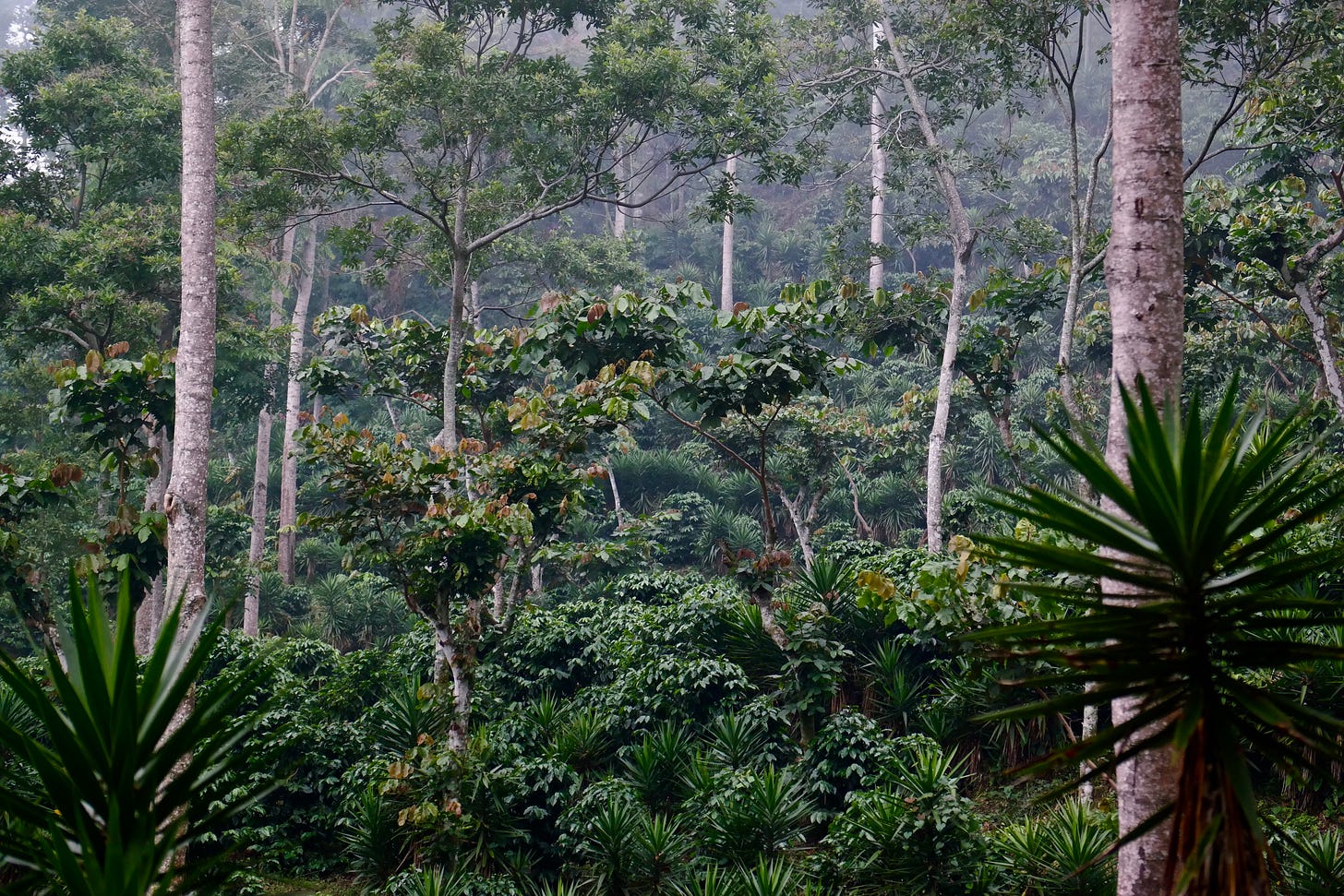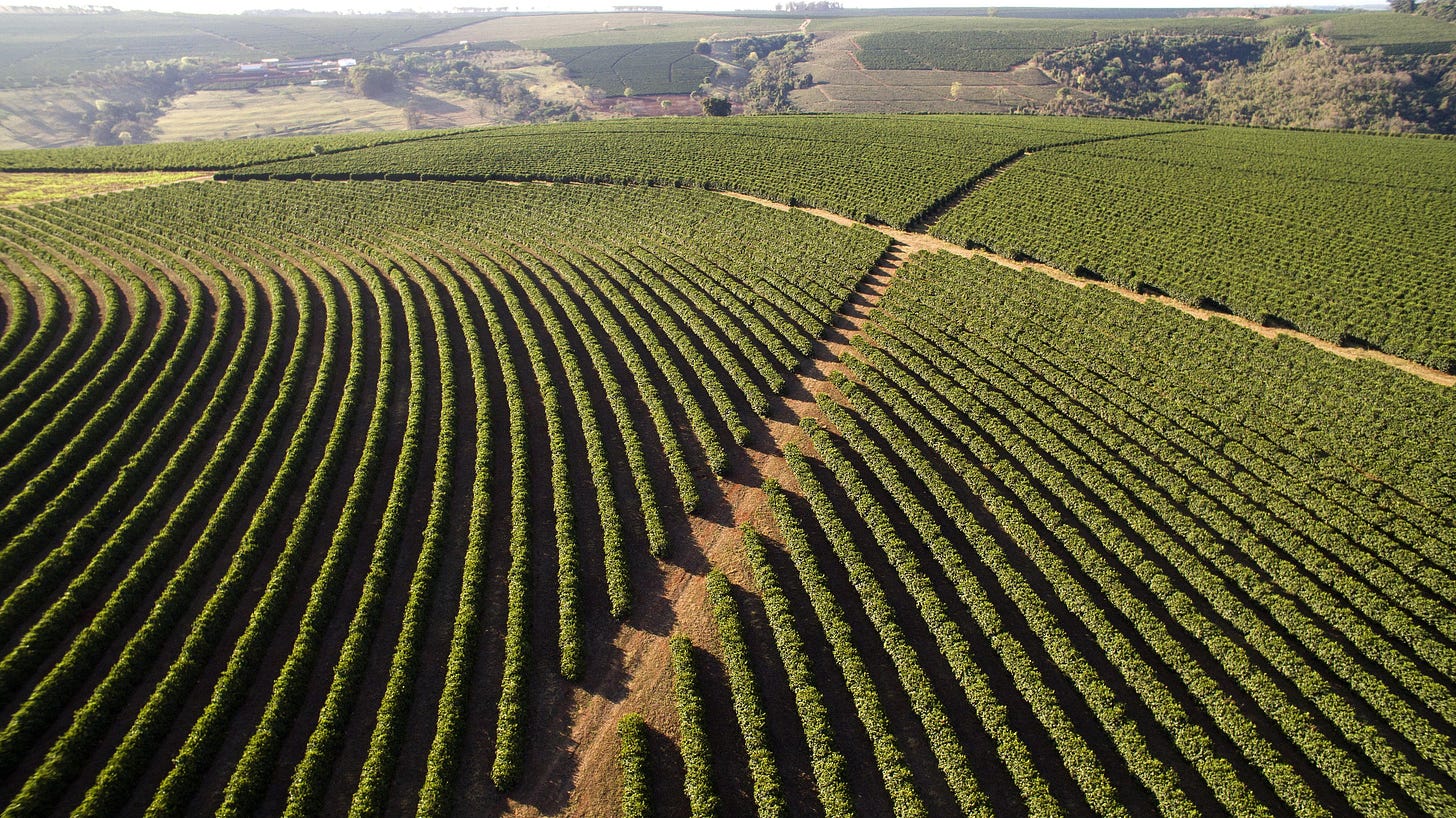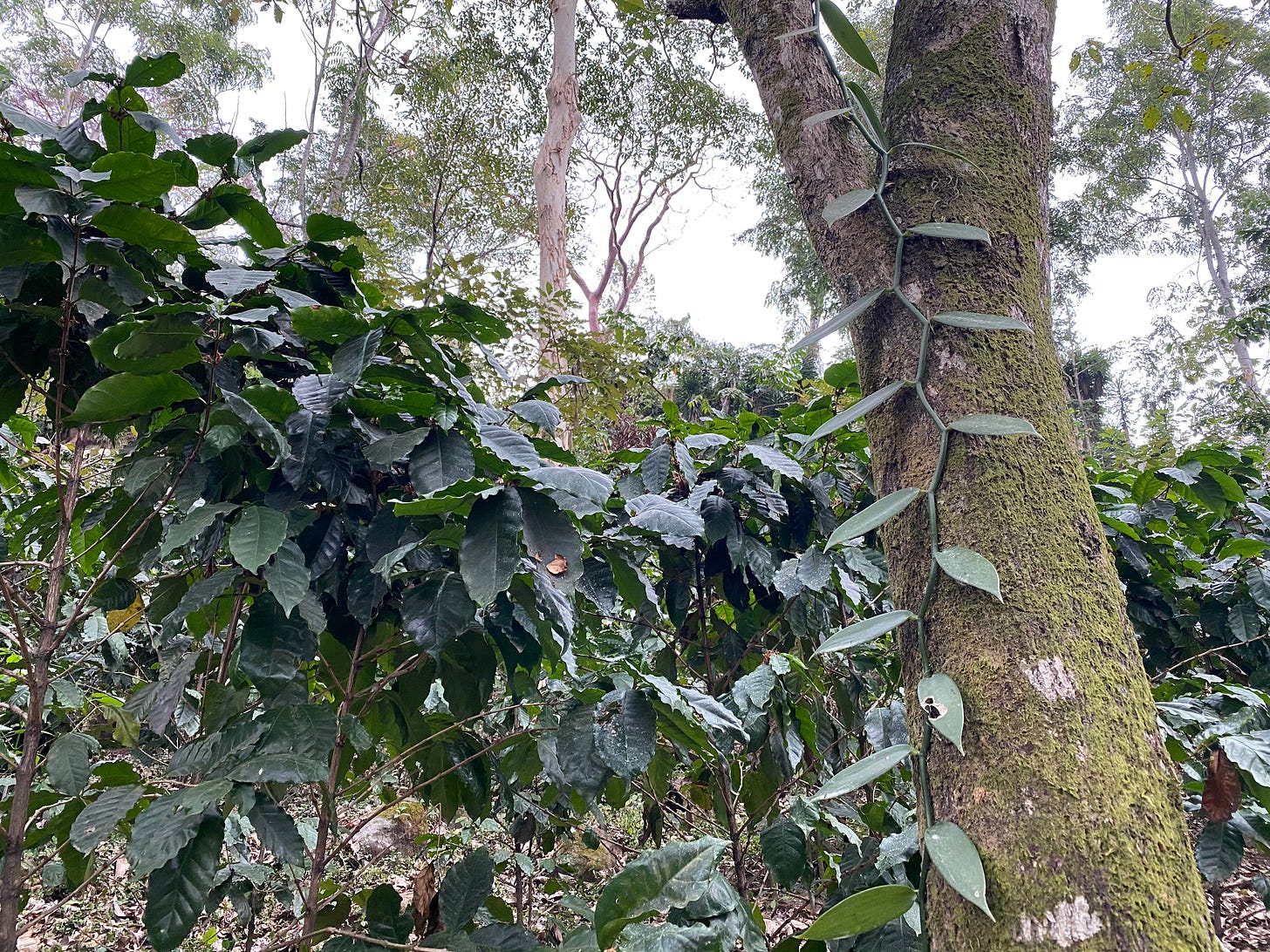The once-predictable rhythms of rainfall and temperature that coffee farmers relied on for generations are breaking down. Across the world's coffee belt, producers face increasingly erratic weather patterns—extended droughts followed by sudden downpours, once in a lifetime frosts, and rising temperatures. While global climate change plays a role in this disruption, a more immediate and troubling reality emerges when we look closely: coffee farmers are inadvertently changing their own local climates through their cultivation practices.
This isn't just an unfortunate coincidence—it's a self-reinforcing cycle with clear cause-and-effect relationships. The shift from traditional shade-grown coffee to sun-exposed varieties, widespread forest clearing, degradation of soil health, and disruption of water systems have created a vicious feedback loop that threatens the future of coffee itself. Like pulling threads from a tapestry, each change weakens the fabric of these agricultural ecosystems until the whole system begins to unravel.
The numbers tell a sobering story. About 37% of the world's coffee grows on land that was once forest. The coffee industry has cleared over 2.5 million hectares—an area nearly four times the size of Delaware. For every cup of coffee consumed approximately one square inch of forest was converted to coffee production.
This isn't slowing down. Each year, about 130,000 hectares of forest disappear to make way for new coffee plantations as farmers respond to economic pressures and growing global demand. Coffee consumption has increased 60% over the last three decades, with each new coffee drinker unwittingly contributing to this transformation.
These forests served as natural climate stabilizers for the very regions now struggling with weather extremes. By removing them, coffee producers have dismantled the ecological infrastructure that once protected their farms.
Coffee, in its natural state, isn't a full-sun crop. Coffea arabica evolved as an understory plant, growing beneath the dappled light of forest canopies. Its biology is exquisitely adapted to these conditions. Yet modern coffee production has increasingly abandoned this natural arrangement in favor of sun-loving varieties planted in open fields.
For good reason many coffee growers have been enticed by shadeless systems. Sun-grown coffee can produce three times the yield of traditional shade-grown plants. But this productivity comes with significant ecological costs that eventually undermine those very gains, in most cases leading to an eventual drastic decline often preceded by a surge in input requirements.
Shade-grown coffee systems harness the trees' natural constraints rather than fight against them. The diverse tree canopy above coffee plants regulates water flow like a well-designed irrigation system. During heavy rains, the multilayered vegetation slows water's journey to the soil, reducing erosion and flooding. During dry periods, the shade reduces evaporation and transpiration rates, keeping more moisture available for coffee plants when they need it most. Research shows that coffee plants in these systems experience significantly less water stress during drought conditions.
Sun-grown plantations strip away this natural infrastructure. Without protective tree cover, heavy rains hit bare soil with full force, washing away fertile topsoil and creating destructive runoff. Studies have documented dramatically higher erosion rates—often 3-5 times greater—in sun coffee systems compared to shade operations. The exposed soil heats up more quickly, increasing evaporation and reducing the land's ability to store water for dry periods. These systems essentially trade long-term resilience for short-term production gains.
One of the more fascinating (and concerning) aspects of coffee's ecological impact is how deforestation disrupts the very rainfall patterns farmers depend on. This isn't distant climate change; it's localized weather modification happening in real-time.
Trees don't just passively receive rain—they actively create it. Through evapotranspiration, forests pull groundwater up through their roots and release it as vapor through their leaves. This moisture creates what's referred to as "flying rivers"—streams of water vapor that flow through the atmosphere and eventually condense into rainfall. Measurements confirm that air masses passing over intact forests produce approximately twice as much precipitation as those traveling over deforested areas.
When coffee farms clear forests, they break this water cycle. The evidence is becoming increasingly clear in major growing regions. In Ethiopia's coffee heartland, farmers who once relied on predictable rainfall patterns now face extended dry periods punctuated by intense, often destructive downpours. Central American producers report similar changes—droughts lasting weeks longer than historical averages, followed by rainfall so intense it damages coffee plants and triggers landslides on exposed hillsides.
The cruel irony is that in attempting to produce more coffee by clearing trees, farmers are sabotaging the very climatic conditions that make coffee cultivation possible. They're cutting down their irrigation system.
Beneath the visible changes to coffee landscapes lies an equally important transformation in the soil itself. Healthy soil isn't just a substrate—it's a complex living ecosystem containing billions of microorganisms that cycle nutrients, maintain structure, and regulate water flow.
Traditional coffee cultivation practices, particularly shade-grown systems, support this underground ecology. Leaf litter from diverse trees continuously feeds soil organisms, building organic matter that acts like a sponge for water retention. Studies in Colombia have shown that shade coffee systems maintain soil organic matter levels two to three times higher than sun-grown plantations.
As farms transition to intensive sun cultivation, this soil ecosystem deteriorates. Without regular organic inputs and with increased exposure to sun and rain, organic matter declines and soil structure weakens. The numbers are striking: a typical intensive coffee plantation loses 2-3% of its topsoil annually through erosion, approximately 10-15 tons per hectare per year. After about 20 years, many of these farms become so degraded they can no longer support productive coffee plants.
The consequences extend beyond individual farms. When heavy rains hit degraded soils, the runoff carries sediment into waterways, reducing water quality and causing downstream flooding. The 2020 hurricanes Eta and Iota provided a catastrophic demonstration of this principle, triggering devastating landslides across Central American coffee regions where soils had been weakened by decades of intensive cultivation.
A particularly interesting discovery from recent research challenges a common assumption about trees in coffee systems: rather than competing with coffee for water, shade trees and coffee plants often form a complementary relationship.
Using isotope analysis to track water movement through plants, researchers found that coffee plants primarily draw moisture from the top 15 centimeters of soil, while shade trees access deeper water sources below this level. This natural resource partitioning means the plants aren't competing as directly as previously thought. Instead, they're accessing different parts of the soil's water profile.
This complementary relationship extends to other resources as well. Many common shade trees in coffee systems, particularly legumes like Inga species, fix atmospheric nitrogen that benefits coffee plants. Their deeper root systems also bring up nutrients from subsoil layers that would otherwise remain inaccessible to the more shallow-rooted coffee.
The microclimate benefits are equally important. Measurements in agroforestry coffee systems show temperature reductions of 2-5°C under shade canopies compared to open sun plantations. This can be critical during heat waves that might otherwise damage coffee flowers or developing cherries. During one recent heat wave in Colombia, shade coffee farms maintained 85% of normal production while nearby sun farms saw yields drop by up to 40%.
The evidence uncovers a vicious cycle within coffee-growing regions where deforestation for coffee leads to local climate changes, which reduce coffee production, creating economic pressure that drives further destructive practices and ecological deterioration.
This cycle is already affecting major coffee regions. In Brazil's primary growing areas of São Paulo and Minas Gerais, temperature increases and rainfall changes linked to Amazon deforestation are reducing suitable growing areas. Research shows that when coffee plants experience temperatures above 30°C (86°F), they develop physiological stress that affects both yield and quality.
Climate models indicate that by 2050, up to 50% of current coffee-growing land could become unsuitable, putting nearly half the world's production at risk. In Timor-Leste, for example, areas suitable for arabica cultivation are expected to shrink from 33.2% of the country to between 16.6% and 22%, depending on emission scenarios.
For the 25 million farmers who depend on coffee for their livelihoods, these changes represent an existential threat. Many small-scale producers lack the resources to pivot to another crop or significantly change their practices without support. In areas of Central America it’s not uncommon to find abandoned coffee farms, or coffee farms that have been converted to subsistence corn and bean farms.
Breaking the Cycle: Practical Solutions with Proven Results
The good news is that understanding this self-reinforcing cycle points toward clear solutions. By working with natural systems rather than against them, coffee production can become not just sustainable but regenerative—actually improving environmental conditions over time.
Several approaches show particular promise:
Keyline water management offers one of the most effective approaches for coffee landscapes. Originally developed by P.A. Yeomans for Australian farms, this system works with natural topography to redistribute water more evenly across the landscape. By identifying key points in the terrain and implementing specially designed cultivation patterns that run slightly off-contour, farmers can direct water from moisture-rich valleys toward drier ridges. For coffee producers, particularly those in regions facing increasing drought, this technique creates remarkable resilience while reducing erosion during heavy rains. When implemented properly, Keyline-designed farms have shown water retention improvements of 30-40% compared to conventional planting methods.

Continuous living soil cover represents a foundational strategy for hydrological restoration in coffee landscapes. Maintaining year-round vegetation between coffee rows—whether through managed spontaneous growth, strategic cover crops, or perennial understory species—creates a protective interface between soil and atmosphere that transforms water dynamics. Field measurements demonstrate that covered soils absorb 4-6 times more rainfall than bare surfaces, with infiltration rates increasing from approximately 1.5 cm/hour to 15-20 cm/hour. This enhanced permeability redirects precipitation from destructive surface runoff into groundwater recharge, effectively transforming farms into water-harvesting systems. The dense root networks of cover plants create biologically-engineered porosity that allows water to penetrate deeply, while simultaneously stabilizing fragile tropical soils against erosion. Beyond these hydrological benefits, continuous living cover contributes to microclimatic regulation, with interspersed vegetation reflecting less solar radiation and maintaining up to 15% higher relative humidity in the coffee understory, critical during increasingly frequent heat stress events.
Soil restoration provides perhaps the greatest return on investment in regenerative coffee systems. Building soil organic matter by just 1% can increase water-holding capacity by approximately 20,000 gallons per acre—a critical buffer against increasingly erratic rainfall patterns. The enhancement of soil vitality forms the metabolic foundation of regenerative coffee systems, not merely preserving soil structure but actively developing its biological complexity, aggregate formation capacity, and carbon sequestration potential. Regenerative coffee farms that maintain diverse ground cover between rows demonstrate 40-60% less erosion than bare-soil systems, while simultaneously establishing complex soil food webs that continuously release plant-available nutrients.
Returning to shade systems represents a fundamental realignment with coffee's natural ecology as an understory plant. Coffea arabica evolved beneath forest canopies, and multi-strata agroforestry systems recreate these conditions through strategic integration of complementary species. Shade trees and coffee plants form complementary relationships, with coffee accessing upper soil moisture while deeper-rooted shade trees draw from subsoil reserves—effectively partitioning resources rather than competing. During the devastating coffee leaf rust outbreak of 2012-2013, shade farms in Central America experienced infection rates 30% lower than neighboring sun plantations. The microclimate benefits are equally significant: measurements in agroforestry systems show temperature reductions of 2-5°C under shade canopies compared to open plantations, critical protection during increasingly frequent heat waves that might otherwise damage coffee flowers or developing cherries.
While each of these practices offers significant benefits individually, their true regenerative potential emerges through strategic integration into cohesive agricultural systems. These practices function not as isolated interventions but as interconnected components of a living agricultural ecology, where each element amplifies the effectiveness of others through well-documented functional relationships:.
Coffee stands at a crossroads. The industry can continue down the path of ecological ruin—clearing forests, exposing soil, and fighting against the very systems that would naturally support coffee production. Or it can embrace complexity, working with ecological principles to create resilient production systems that weather climate challenges.
Navigating the Transition: Overcoming Barriers to Regeneration
The implementation of regenerative coffee systems faces significant structural and knowledge-based barriers that cannot be overlooked in realistic transition planning. Economically, the initial investment in system redesign—from establishing shade trees to reconfiguring water management infrastructure—requires capital that many smallholder farmers simply cannot access under current financing models. This system design will require support and buy-in from the entire coffee value chain.
A particularly instructive example of this dynamic emerged following the devastating 2012 coffee leaf rust epidemic that decimated Central American production. Rather than supporting comprehensive agroecological transformation, institutional responses predominantly channeled farmers toward narrow genetic solutions—particularly the widespread adoption of "rust-resistant" varieties like Lempira in Honduras. These varieties were aggressively promoted as technological silver bullets requiring minimal system redesign. By 2017, however, the Honduran coffee institute (IHCAFE) confirmed what ecological principles would have predicted: the much-touted resistance had collapsed. Genetic fingerprinting verified that Lempira plants throughout the country had become susceptible to rust, likely due to pathogen evolution or the introduction of previously rare rust races against which the variety had no resistance.
This case exemplifies how simplified technological interventions that fail to address root systemic causes inevitably fall short. The economic and institutional architecture of coffee production continues to direct farmers toward input-substitution approaches rather than transformative redesign, despite mounting evidence that the latter generates superior resilience. Knowledge barriers compound these challenges—transitioning to regenerative systems requires sophisticated ecological understanding that contrasts sharply with the standardized technical packages that have dominated agricultural extension for decades.
Despite these barriers, empirical documentation from pioneering regenerative coffee landscapes demonstrates compelling economic returns once systems mature. The transformation of Finca San Jerónimo provides one of the best case studies of regenerative transition in the context of coffee farming. This farm—previously locked in a cycle of input dependency with escalating applications of synthetic fertilizers, herbicides, and an aggressive rotation of several fungicide classes—has undergone comprehensive system redesign with quantifiable results across multiple parameters.
The transition protocol implemented at San Jerónimo systematically eliminated synthetic nitrogen-phosphorus-potassium (NPK) applications while concurrently establishing perennial ground cover diversity and stratified shade canopy. Productivity metrics contradict conventional agricultural assumptions. Despite the complete elimination of synthetic fertility inputs, yields remained stable during the transition period, and ultimately increased. Meanwhile, cup quality scores improved across all varieties, most markedly in the typically lower-performing rust-resistant varieties, which commanded corresponding price premiums in direct-relationship markets with quality-focused roasters.
Perhaps most striking are the pest and disease management outcomes. Coffee leaf rust (Hemileia vastatrix) incidence decreased from annual averages of 40% under conventional chemical control regimes to current levels below 1% using exclusively biological controls and enhanced plant nutrition protocols. The establishment of perennial polyculture ground cover eliminated herbicide requirements, reduced erosion rates and ameliorated soil organic matter development compared to previous bare-soil management practices, according to field measurements.
The farm's functional diversification strategy now yields revenue streams from premium hardwoods, specialty cacao, unique spices, and diverse tropical fruits alongside its award-winning coffee—a portfolio that stabilizes economic returns while enhancing ecological function. Crucially, this systemic redesign has secured committed long-term purchasing relationships with specialty roasters who recognize the ecological value embedded in the production system.
The San Jerónimo case exemplifies a common observation across diverse agricultural transitions: systems grounded in ecological principles generate demonstrably superior outcomes across economic, social, and environmental parameters. These returns stem directly from enhanced ecosystem function through the restored hydrological cycles, microclimatic regulation, and soil biological activity that form the foundation of sustainable productivity which became increasingly evident through each year of the monitoring program.
What makes this situation particularly poignant is that coffee, naturally evolved to thrive in forest ecosystems, could be part of the solution rather than the problem. Through agroforestry approaches, coffee cultivation could help regenerate landscapes, stabilize local climates, and ensure sustainable production for generations to come.
Sun-grown, deforestation-based coffee carries within it the seeds of its own decline. As natural systems degrade, so does productivity—creating a downward spiral that ultimately undermines both ecological and economic sustainability.
The alternative—shade-grown, ecologically integrated coffee—represents not just an environmental choice but an economic necessity for the future of coffee. By restoring the ecological foundations that support stable local climates, coffee producers can break the cycle of degradation and build truly enduring and resilient production systems.
If you made it this far, check out my forthcoming white paper that defines and describes the principles and science of regenerative coffee farming. I will also be releasing several technical manuals on the same topic and will announce practical workshops and other events at one of the demonstration farms I’ve helped develop. Sign up here: https://www.regen.coffee












I visited an inspiring organic shade system in Costa Rica this time last year - not only wonderfully biodiverse but the coffee was award winning and because of the lower yields they were selling to independent coffee roasters across the US. And true to organic principles they were paying a fair wage to the workers ( which is another story)
You did it again Sam. You always give me much to think about and I get to learn something new.